About Auricular Medicine
Welcome to Auricular Medicine International Research & Training Center online! For more than 10 years, we have provided to all people worldwide with professional auricular medicine services to help improve their mental and physical health. Our services are perfect for anyone who wishes to enhance their current health, relieve pain and stress, or recover from illness or injury.
What is Auricular Medicine?
Auricular Medicine is a highly developed system of diagnosis and treatment, discovering ailments 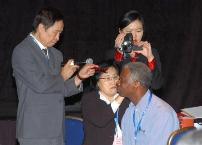 anywhere in the human body by expertly examining the ear, which the well trained practitioner can accurately determine symptoms and root causes of diseases. anywhere in the human body by expertly examining the ear, which the well trained practitioner can accurately determine symptoms and root causes of diseases.
Auricular Diagnosis, unlike any other medical systems, auricular medicine can examine the physical conditions of a person in a very simple, low cost, but precise way. By checking different auricular points, one can get information about the health condition of a person. More importantly, it can also give the history information of the diseases and also predicts the potentials of certain diseases such as diabetes. Other medical systems are imprecise or complex, expensive, and time consuming.
|
|
|
Auricular Diagnosis is done through the following methods:
1) Inspection
This is a diagnostic method used to observe discoloration, deformity, desquamation, papule, and angioplerosis on the auricle. It is usually used for various acute or chronic diseases and for acute attack of chronic diseases. It is mainly applied to locate or treat the area of disease and for qualitative diagnosis.
2) Tenderness Method
It is a diagnostic method that employs the use of a probe or the detecting pen of an auricular detecting instrument to touch and to feel for tender auricular points, observe the reaction of the patient, and then use the key tender points to diagnose a disease. When a person suffers from an illness, especially for an acute disease or tumor, the phenomena of a lower pain threshold and sensation to pain will appear on the auricular point. This is the basis of the Tenderness Method. This method is applied for diagnosing various acute diseases, painful diseases, determining the nature or differentiating a tumor, and treatment of diseases.
3) Pressing Mark Method
It is a diagnostic method that employs the detecting pen to press the auricle and to observation the pressing mark. When a person is ill, a deformity such as an eminence or swelling will appear on the corresponding point on the auricle. The pressing marks have a difference in depth, coloration and the time of recovery. That is the basis of clinical diagnosis. This method is mainly used for acute and chronic diseases. We also use it to differentiate deficient and excess syndromes.
4) Palpation
This diagnostic method employs the use of touch. A detecting pen is used to touch reactions, such as protrusion, depression, edema or swelling. The point on the auricle will change its form variously along with the occurrence and development of the pathological changes when the person suffers from a disease. For chronic and organic diseases, a permanent mark will remain on the auricle after the disease has been cured.
The Method of Palpation has developed rapidly within the last ten years. It improves the application of the single point, especially the diagnosis and differentiation of one point for multiple diseases. It also enlarges the limits of auricular diagnosis and increases the coincident rate.
The Palpation method is mainly applied for the diagnosis of chronic, organic disease, or the study of a case history of the patient.
5) Auricular Electrical Detection
This is a diagnostic method that measures the auricular cutaneous resistance. Analyzing the auricular points and taking the results can be a reference for diagnosis and as a foundation of point selection. When a person is suffering or has had a disease, the cutaneous resistance of the auricular points which relate to the disease will decrease dramatically. So with an auricular detector, we can measure such change. The information we gathered can be applied for locating areas of concern and qualitative diagnosis. Electrical detection is used for acute and chronic disease, acute attack of chronic disease, tumor, painful disease, and the estimation and judgment of blood pressure. We can increase the coincident rate by using palpation in conjunction with electrical detection.
6) Auricular Electrical Computer Diagnosis
This method employs a computer to measure the resistance of the auricular points and the average 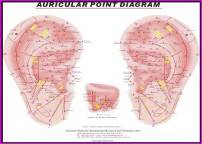 resistance of reference auricular points and to calculate these numbers and show percentages which indicate the change of resistance of the auricular points. Then the doctor can make a diagnosis based on the change of a percentage of relevant auricular points and other pertinent information. The application of computer technology may increase the degree of accuracy, exclude the effect of various unstable factors and show the change accurately and numerically. Thus it overcomes the shortcomings of manual diagnosis. resistance of reference auricular points and to calculate these numbers and show percentages which indicate the change of resistance of the auricular points. Then the doctor can make a diagnosis based on the change of a percentage of relevant auricular points and other pertinent information. The application of computer technology may increase the degree of accuracy, exclude the effect of various unstable factors and show the change accurately and numerically. Thus it overcomes the shortcomings of manual diagnosis.
7) Auricular Comprehensive Diagnosis
The multiple diagnostic methods assign diagnostic values according to the stage of the disease. Some are applicable to the diagnosis of acute or painful diseases and some are applicable in the diagnosis of chronic or organic disorders. Through clinical observation, we have found that the main change for acute disease is a decrement of pain threshold and resistance of relevant auricular points. So palpation and electrical detection are usually applied for acute disease. For a chronic disorder, the main change is deformity of relevant auricular points. This is the reason that palpation is always used for chronic disease. So, it is very difficult to analyze and to have an all around judgment of the acute or chronic disorder of the whole body, as well as to make an accurate diagnosis. In order to find out the complete change of auricular positive points, we put forward the comprehensive diagnostic method: first inspection, second palpation, third measurement and listening, fourth differentiation of syndromes. It is a method applying the multiple methods mentioned above.
First: Inspection. The inspection is also called observation. For the first visit of a patient, it is best to do the auricular inspection first to find out the location of the focus and the stage of the disorder. Then we can make a further judgment according to the findings of palpation and electrical detection.
Second: Palpation. Tenderness is the main change of acute disease, painful disease and the severe stage of a disorder. A deformity is the main change of chronic and organic disease. Palpation is very important in order to find out special changes of the auricular points. Palpation includes four detecting methods: 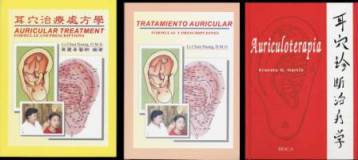 Tenderness Method Pressing Mark Method Finger Feeling Method Pen (probe) Detecting Method
Third: Electrical Detecting and Listening. It is a method of detection of the auricle with an auricular electrical detector, which can show the disorder in several ways. Then we analyze the positive reactions. Usually we will finish the palpation, electrical detection and listening at the same time. When examining the auricle with the pen of the auricular electrical detector, we pay attention not only to the numbers and sound but also to the form of the points touched by the detecting pen to see whether there are deformities such as a depression, protrusion, node, cord, or edema. This method is significant for the observation of the change in color and form of those points that tested positive by the number and sound.
Fourth: Differentiation of Syndromes. It is a comprehensive method of the positive reactions we obtain through the three methods mentioned above, combined with the case history and applying the knowledge of TCM and Western Medicine, then we can make an accurate, differential diagnosis and provide a basis for treatment.
|
Auricular Treatment
Ears have been used to treat diseases in China for more than 2000 years. Based on the Theory of 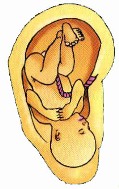 "Reversed Embryo", ears reflect the condition of the human body. Auricular Points are the specific locations that corresponding to a part of the body. By stimulating the auricular points, we can treat the disharmony of its corresponding part(s). There are 16 important auricular treatment methods that have been developed, such as the Auricular Filliform Therapy, Auricular Electro-Acupuncture, and Auricular Point Injection Therapy.Among these, Auricular Seed Therapy, Auricular Massage, and Bleeding are the most commonly used in Auricular Medicine, because of their simplicity and efficiency. "Reversed Embryo", ears reflect the condition of the human body. Auricular Points are the specific locations that corresponding to a part of the body. By stimulating the auricular points, we can treat the disharmony of its corresponding part(s). There are 16 important auricular treatment methods that have been developed, such as the Auricular Filliform Therapy, Auricular Electro-Acupuncture, and Auricular Point Injection Therapy.Among these, Auricular Seed Therapy, Auricular Massage, and Bleeding are the most commonly used in Auricular Medicine, because of their simplicity and efficiency.
Auricular Seed Therapy
This is also referred to as the "seed-pressure" method. It refers to applying a hard, smooth seed, herb, a pill or drug, or a magnetic pellet on tape, to a selected auricular point, and pressing it properly, to stimulate the point, to treat various diseases. It is the most popular treatment methods under development in the past 25 years. Auricular Seed Therapy was developed through Auricular Filliform Needling and Auricular Needle Imbedding Therapy. Even though Auricular Filliform Needling and Auricular Needling Embedding Therapy are very effective in treating many diseases; needle insertion undoubtedly produces pain, which scares away many a potential patient. 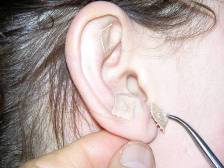 Auricular Treatment, on the other hand, is safe and painless. The patient can even constantly stimulate him/herself by pressing the seeds attached to the acupoints. This method is very suitable for children, or those others who are afraid of pain, or who can not receive treatment everyday. Through clinical practice records, it has been confirmed that Auricular Seed Therapy is more acceptable by the patients, yet can achieve satisfactory therapeutic effects. Auricular Massage Therapy Massage is an external method of preventing and treating various diseases, by pressing, rubbing, kneading, twisting, pinching, digital pressing, and fingernail pressing. It is easy and simple. By massaging the ear correctly, one can help treat and prevent diseases.
There are two auricular massage methods commonly used: self-auricular massage and auricular point massage. Self-auricular Massage is performed using pressing, rubbing, lifting, or kneading to specific areas of the auricle. Self-auricular Massage may be painless and can be applied extensively and instantly as an accessory treatment, especially in the treatment of headache, neurasthenia, and hypertension.
 Persistent massage of the auricle in the morning and evening may achieve excellent health care effects, such as promoting circulation of Qi and blood, dredging the channels and collaterals, regulating the functions of internal organs, invigorating the spleen, replenishing Qi, tonifying the kidneys, and improving hearing. Persistent massage of the auricle in the morning and evening may achieve excellent health care effects, such as promoting circulation of Qi and blood, dredging the channels and collaterals, regulating the functions of internal organs, invigorating the spleen, replenishing Qi, tonifying the kidneys, and improving hearing.
This method is also called "Reinforcing the City Wall." The massage methods are as follows:
Auricular Point Massage: also referred to as "intensive Auricular Point Massage." There are three methods commonly used: Point Pressing; Finger Nail Pressing; and Kneading and Pressing.
Point pressing presses the treatment point that is related to the disease with a probing stick, a flexible pressing stick, or the tip of the doctor's finger.
This method may also be accomplished with the Digital Maneuver Acupoint Pressure, one of the skills of Qigong. Point pressing is indicated to relieve pain, prevent diseases, and preserve health.
Finger Nail Pressing presses a selected point with thumbnail on the anterior of the point, and with the nail of the index finger on the posterior of the point, gradually press harder and harder. Apply light manipulation when helping those with a weak constitution, and apply heavy manipulation when helping those with strong constitutions.
One to three points may be selected for each treatment. This method is suitable to treat painful diseases, such as toothache, headache, stomachache, hepatalgia, and the common cold.
Kneading and Pressing kneads and presses a selected point or area clockwise with a tender stick, or with the tip of an index finger gradually harder and harder until the patient has the sensation of the heat, distention, and comfort. This method is suitable for infants, children, painful diseases, indigestion, and patients with a sensitive constitution.
Auricular Bleeding Therapy
This is a method of treating disease by puncturing selected auricular point(s) with an auricular filliform needle, intradermal needle, etc. 
This method is indicated to treat high fever and colonic convolutions due to fever, pain due to blood stasis, headache, dizziness and vertigo due to hyperactivity of liver yang, swelling and pain of conjunctiva, constipation, and dermatosis due to excessive heat of the lungs and large intestine.
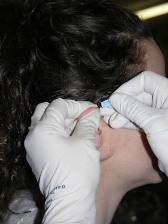 Auricular Bleeding Therapy is extremely efficient in dredging the channels, promoting blood circulation by removing blood stasis, tranquilizing the mind, clearing away heat, and relieving inflammation and pain. Auricular Bleeding Therapy is extremely efficient in dredging the channels, promoting blood circulation by removing blood stasis, tranquilizing the mind, clearing away heat, and relieving inflammation and pain.
Thus, Auricular Treatment is very different from acupuncture because it doesn´t penetrate the body and is basically painless. When the seeds remain on the ear for about a week, the patients can treat themselves, and thus better results can be obtained. This is a natural drug-free approach.
Auricular Treatment has been proven to be efficient in treating many diseases, including endocrine disease, and various pain symptoms.
|
|